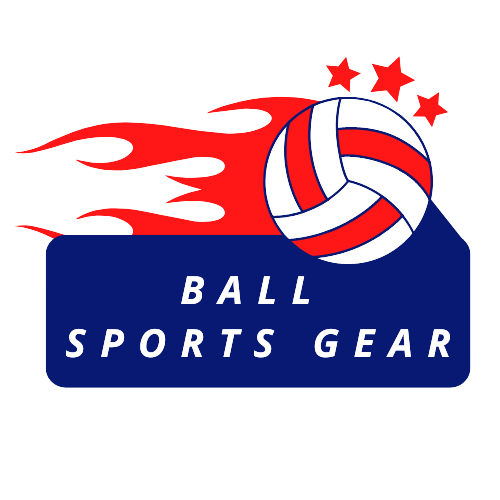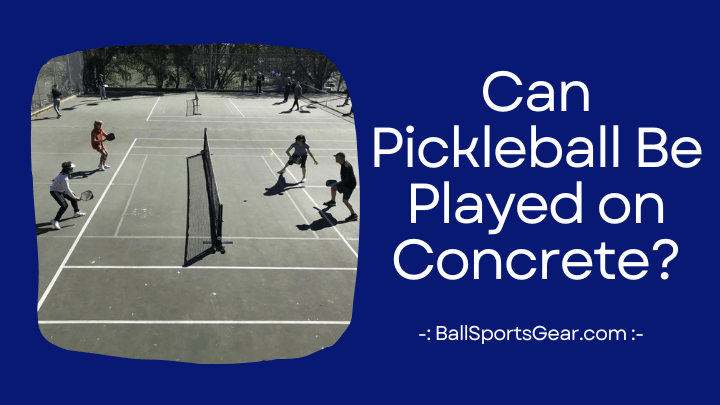Pickleball, a popular racket sport that combines elements of tennis, badminton, and table tennis, has gained immense popularity in recent years. As enthusiasts of the game continue to grow, questions arise regarding the playing surface suitable for pickleball. One common query is whether Can Pickleball Be Played on Concrete? In this brief exploration, we will examine the feasibility of playing pickleball on a concrete court and discuss the implications of this playing surface.
Can Pickleball Be Played on Concrete?
Type and Condition of the Concrete:
When considering playing pickleball on concrete, it’s important to assess the type and condition of the surface. Concrete can vary in its composition and texture, which can impact the gameplay and players’ safety. Ideally, the concrete should be relatively smooth, free from cracks, and provide adequate traction to prevent slipping. It’s worth noting that some concrete surfaces may be too rough or abrasive, increasing the risk of injuries and affecting the ball’s bounce.
Weather Conditions:
Weather conditions play a significant role in the feasibility of playing pickleball on concrete. In hot and dry climates, concrete surfaces tend to become extremely hot, which can make it uncomfortable to play and potentially cause discomfort or even burns. Additionally, extreme heat can affect the ball’s bounce, making it harder to maintain a consistent and fair game. Conversely, in cold and wet conditions, concrete can become slippery, increasing the risk of falls and injuries.
Equipment Considerations:
Playing pickleball on concrete may require some adaptations in terms of equipment. Firstly, the type of shoes worn becomes crucial. It’s essential to wear appropriate footwear that provides good traction on concrete surfaces to minimize the risk of slips and falls. Secondly, the choice of balls can impact the gameplay. Harder balls, such as outdoor pickleballs, are more suitable for concrete surfaces, as they can withstand the rougher surface and still provide a decent bounce.
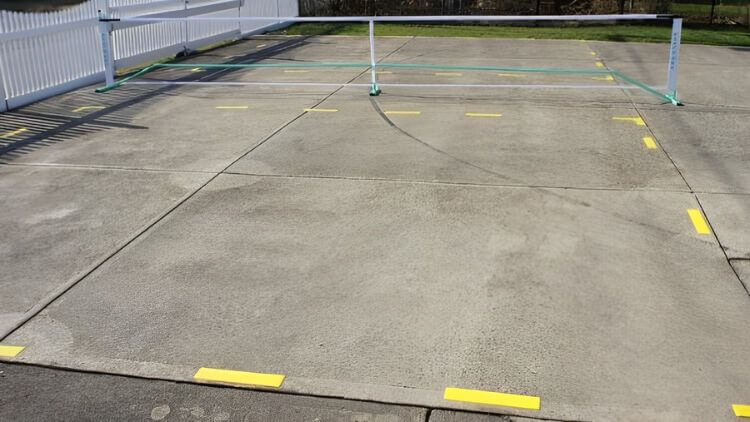
Safety Measures:
To ensure a safe playing experience on concrete, there are some additional safety measures to consider. Firstly, it’s advisable to inspect the playing area for any potential hazards, such as cracks or uneven surfaces, which may increase the risk of accidents. Additionally, players should be cautious when making quick movements, as the hardness of the concrete can lead to more impactful falls. Lastly, players should communicate and be aware of each other’s movements to avoid collisions.
Pros and Cons of Playing Pickleball on Concrete
Pros
Accessibility:
One of the biggest advantages of playing pickleball on concrete is its widespread accessibility. Concrete surfaces can be found in various locations, such as driveways, parking lots, or even basketball courts. This means that you can easily set up a game wherever there is a suitable flat surface, expanding your options for playing the sport.
Durability:
Concrete surfaces are known for their durability and longevity. Unlike other court surfaces that may require regular maintenance or resurfacing, concrete can withstand heavy usage and does not require extensive upkeep. This makes concrete a cost-effective option for pickleball enthusiasts looking for a long-lasting playing surface.
Consistency:
Concrete provides a consistent playing surface, allowing players to develop a better sense of control and precision in their shots. The ball’s bounce on concrete is generally predictable, which can enhance the overall playing experience and facilitate strategic gameplay. This aspect can be particularly beneficial for beginners who are still honing their skills.
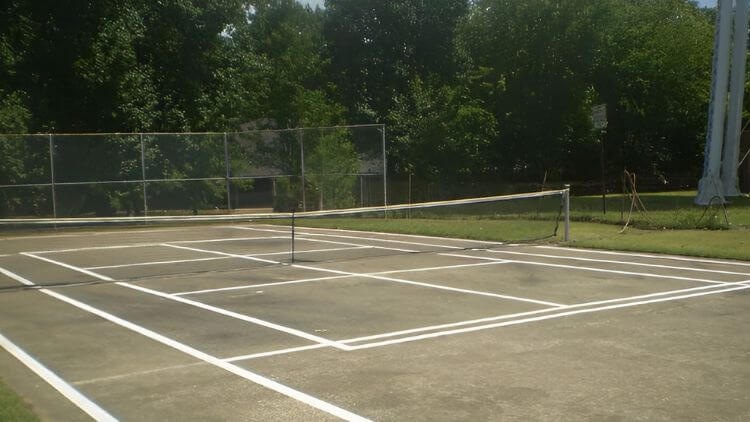
Cons
Hard Impact:
Concrete surfaces are considerably harder than traditional pickleball court surfaces, such as asphalt or cushioned courts. This can result in a more jarring impact on the joints and muscles, potentially increasing the risk of injuries. Players with pre-existing joint issues or conditions may need to take extra precautions or consider playing on a softer surface.
Reduced Shock Absorption:
Unlike cushioned surfaces, concrete does not offer the same level of shock absorption. This can lead to increased strain on the feet, ankles, and knees, especially during prolonged play sessions. Players who experience discomfort or have a history of lower-body injuries may find it more challenging to play on concrete for extended periods.
Surface Hardness:
Concrete surfaces tend to be less forgiving compared to other court materials. The hardness of the surface can cause the ball to bounce higher and faster, altering the dynamics of the game. This may require players to adjust their shots and footwork accordingly, which can be a challenge, especially for those accustomed to playing on softer surfaces.
Building a Pickleball Court on Concrete
If you have a concrete surface available and want to build a pickleball court, there are a few key steps to consider:
- Surface Preparation: The first step in building a pickleball court on concrete is to ensure that the surface is smooth and free of any cracks or irregularities. Use a power washer to clean the concrete thoroughly, and repair any damaged areas using concrete filler or patching compound. Allow sufficient time for the repairs to dry and cure before proceeding.
- Court Markings: To create a regulation-size pickleball court, you will need to mark the boundaries on the concrete surface. The dimensions of a standard pickleball court are 20 feet wide and 44 feet long, with a non-volley zone extending 7 feet from the net on each side. Use measuring tape, chalk, or specialized court stencils to mark the lines accurately.
- Net Installation: Once the court boundaries are marked, you’ll need to install a pickleball net. Portable nets specifically designed for pickleball are readily available and can be set up easily on concrete surfaces. Ensure that the net is positioned at the center of the court and securely anchored to maintain stability during gameplay.
- Court Accessories: Consider adding additional features to enhance the playing experience. Installing boundary fencing or barriers can help contain errant balls and provide a clear distinction between the court and surrounding areas. Adding lighting for night play and benches for resting between games can also be beneficial.
- Surface Considerations: While concrete is a suitable surface for pickleball, you may want to explore options for improving its playability. Applying a surface coating or acrylic paint designed for sports courts can help reduce the surface’s hardness and provide better ball bounce. Additionally, incorporating shock-absorbing mats or rubberized underlayment beneath the court surface can enhance player comfort and reduce the strain on joints.
Why Is Concrete Not a Good Flooring Choice for Pickleball Courts?
Lack of Shock Absorption:
One of the primary drawbacks of playing pickleball on raw concrete is the lack of shock absorption. Unlike dedicated pickleball court surfaces, such as asphalt or acrylic, concrete does not provide cushioning or give when players make quick movements or perform jumps. This can increase the risk of joint injuries, particularly in older players or those with pre-existing conditions.
High Impact on Joints:
Concrete is a rigid material that can transfer a significant amount of impact force to the joints. The repetitive nature of pickleball movements, such as pivoting, lunging, and quick changes in direction, can put strain on the knees, ankles, and hips. Over time, this may lead to joint discomfort and potential long-term injuries.
Limited Surface Traction:
Another challenge of playing pickleball on concrete is the limited surface traction it offers. Concrete can be quite slippery, especially when wet or dusty. This lack of grip can affect players’ ability to make precise movements and quick stops, increasing the risk of slips, falls, and potential injuries.
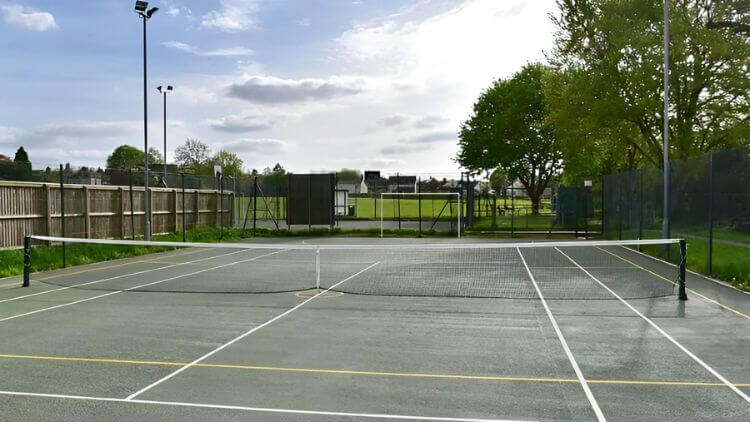
Ball Bounce and Speed:
Concrete surfaces tend to have a faster ball bounce compared to specialized pickleball court surfaces. This can alter the dynamics of the game, making it more challenging for players to control the ball and adjust their shots accordingly. The increased ball speed on concrete can also limit the ability to execute dink shots and delicate drop shots, which are essential elements of the game.
Fatigue and Discomfort:
Playing pickleball on raw concrete for extended periods can lead to fatigue and discomfort. The hard surface can cause strain on the feet and legs, impacting a player’s endurance and overall enjoyment of the game. This discomfort may discourage players from fully immersing themselves in the sport or playing for longer durations.
Frequently Asked Questions
A: Yes, pickleball can be played indoors on concrete floors. However, it is important to ensure that the concrete floors are smooth, clean, and in good condition to provide a suitable playing surface.
A: When playing pickleball on concrete in hot weather, it’s essential to stay hydrated and protect yourself from excessive heat and sun exposure. Consider wearing appropriate clothing, applying sunscreen, and taking regular breaks in shaded areas.
A: Yes, pickleball lines can be painted on concrete surfaces to mark the court boundaries. This helps players identify the correct playing area and adhere to the standard pickleball court dimensions.
Conclusion
In conclusion, Can Pickleball Be Played on Concrete? While pickleball is traditionally played on specially designed courts with surfaces like asphalt or acrylic, concrete can serve as a viable alternative for enthusiasts looking to enjoy the game. Though it may lack the cushioning effect of other surfaces, concrete courts offer durability, cost-effectiveness, and accessibility for players. Whether on concrete or a dedicated court, the most important aspect is the spirit of the game and the joy it brings to those who partake in it. So, gather your paddles, find a concrete court, and enjoy a thrilling game of pickleball.
